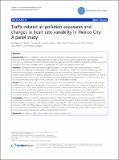Traffic-related air pollution exposures and changes in heart rate variability in Mexico City: A panel study
Author(s)
Shields, Kyra Naumoff; Cavallari, Jennifer M.; Hunt, Megan J. Olson; Lazo, Mariana; Molina, Mario J.; Holguin, Fernando; Molina, Luisa Tan; ... Show more Show less
Download1476-069X-12-7.pdf (603.7Kb)
PUBLISHER_CC
Publisher with Creative Commons License
Creative Commons Attribution
Terms of use
Metadata
Show full item recordAbstract
Abstract Background While air pollution exposures have been linked to cardiovascular outcomes, the contribution from acute gas and particle traffic-related pollutants remains unclear. Using a panel study design with repeated measures, we examined associations between personal exposures to traffic-related air pollutants in Mexico City and changes in heart rate variability (HRV) in a population of researchers aged 22 to 56 years. Methods Participants were monitored for approximately 9.5 hours for eight days while operating a mobile laboratory van designed to characterize traffic pollutants while driving in traffic and “chasing” diesel buses. We examined the association between HRV parameters (standard deviation of normal-to-normal intervals (SDNN), power in high frequency (HF) and low frequency (LF), and the LF/HF ratio) and the 5-minute maximum (or average in the case of PM2.5) and 30-, 60-, and 90-minute moving averages of air pollutants (PM2.5, O3, CO, CO2, NO2, NOx, and formaldehyde) using single- and two-pollutant linear mixed-effects models. Results Short-term exposure to traffic-related emissions was associated with statistically significant acute changes in HRV. Gaseous pollutants – particularly ozone – were associated with reductions in time and frequency domain components (α = 0.05), while significant positive associations were observed between PM2.5 and SDNN, HF, and LF. For ozone and formaldehyde, negative associations typically increased in magnitude and significance with increasing averaging periods. The associations for CO, CO2, NO2, and NOx were similar with statistically significant associations observed for SDNN, but not HF or LF. In contrast, PM2.5 increased these HRV parameters. Conclusions Results revealed an association between traffic-related PM exposures and acute changes in HRV in a middle-aged population when PM exposures were relatively low (14 μg/m3) and demonstrate heterogeneity in the effects of different pollutants, with declines in HRV – especially HF – with ozone and formaldehyde exposures, and increases in HRV with PM2.5 exposure. Given that exposure to traffic-related emissions is associated with increased risk of cardiovascular morbidity and mortality, understanding the mechanisms by which traffic-related emissions can cause cardiovascular disease has significant public health relevance.
Date issued
2013-01Department
Massachusetts Institute of Technology. Department of Earth, Atmospheric, and Planetary SciencesJournal
Environmental Health
Publisher
BioMed Central Ltd
Citation
Shields, Kyra Naumoff et al. “Traffic-related Air Pollution Exposures and Changes in Heart Rate Variability in Mexico City: A Panel Study.” Environmental Health 12.1 (2013): 7.
Version: Final published version
ISSN
1476-069X